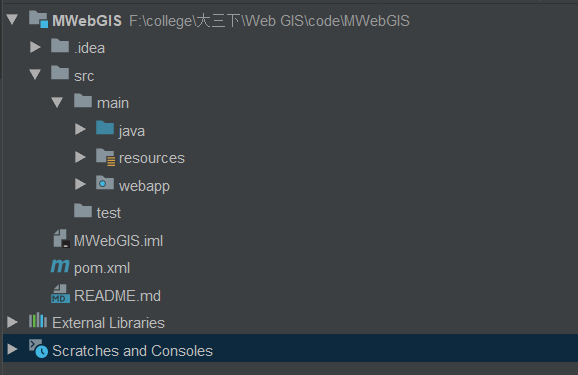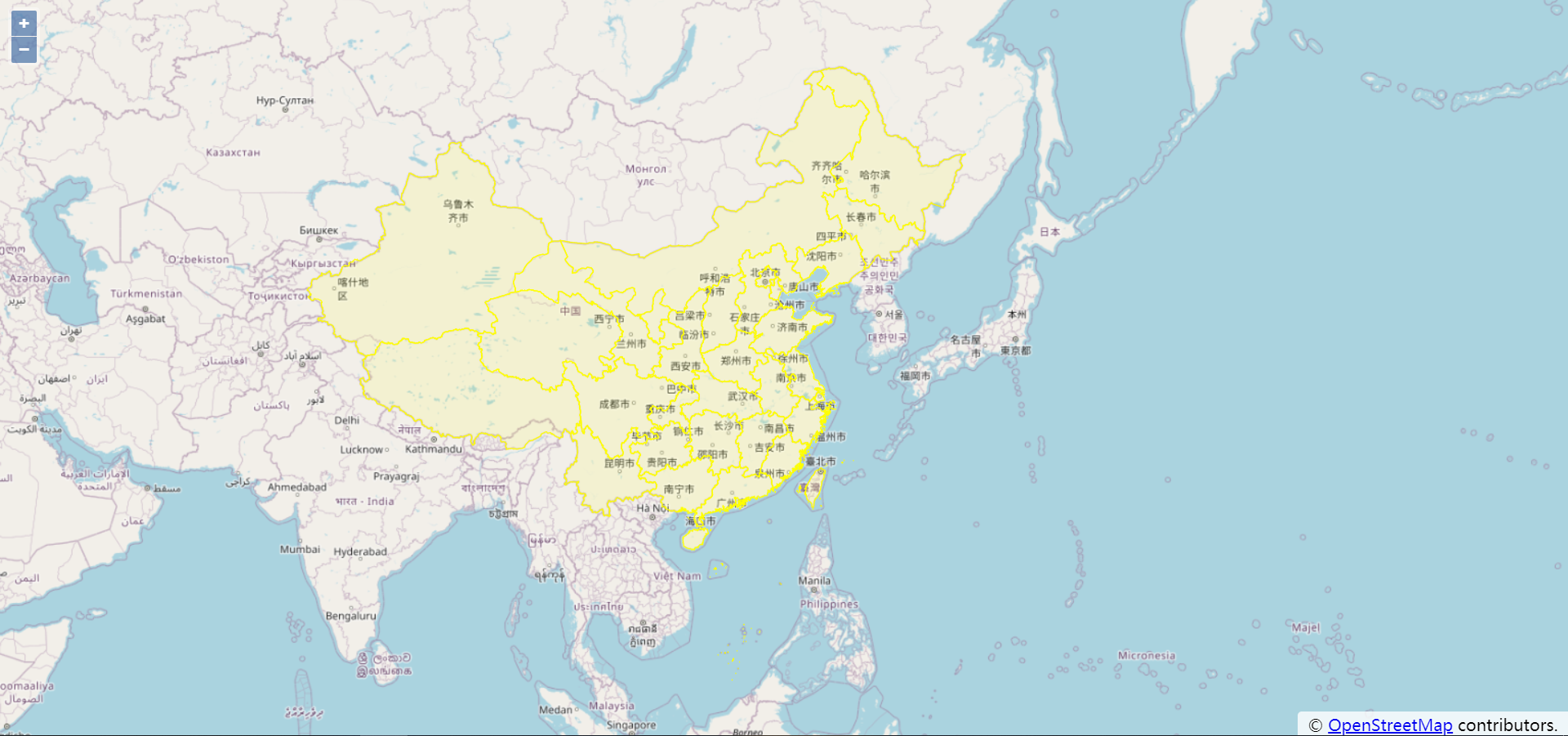Tech: Servlet + jsp
流程: 矢量数据入库 - Openlayers 可视化
PostgreSQL + Servlet + jsp + Openlayers
首先使用命令行将shp数据转化为sql语句:
shp2pgsql "shp路径" "数据库名"> "sql路径"如:
shp2pgsql F:/BoundaryChn2_4p.shp boundary> F:/boundary.sql
然后在pgadmin中执行该sql文件即可。
本次使用maven搭建web程序,文件结构如下:
pom.xml:
<?xml version="1.0" encoding="UTF-8"?>
<project xmlns="http://maven.apache.org/POM/4.0.0"
xmlns:xsi="http://www.w3.org/2001/XMLSchema-instance"
xsi:schemaLocation="http://maven.apache.org/POM/4.0.0 http://maven.apache.org/xsd/maven-4.0.0.xsd">
<modelVersion>4.0.0</modelVersion>
<groupId>com.tm</groupId>
<artifactId>webgis</artifactId>
<version>1.0-SNAPSHOT</version>
<packaging>war</packaging>
<dependencies>
<dependency>
<groupId>junit</groupId>
<artifactId>junit</artifactId>
<version>4.13</version>
<scope>test</scope>
</dependency>
<dependency>
<groupId>org.postgresql</groupId>
<artifactId>postgresql</artifactId>
<version>42.2.12</version>
</dependency>
<dependency>
<groupId>javax.servlet</groupId>
<artifactId>javax.servlet-api</artifactId>
<version>4.0.1</version>
<scope>provided</scope>
</dependency>
<dependency>
<groupId>jstl</groupId>
<artifactId>jstl</artifactId>
<version>1.2</version>
</dependency>
<!--Tomcat引用-->
<dependency>
<groupId>org.apache.tomcat.embed</groupId>
<artifactId>tomcat-embed-core</artifactId>
<version>[9.0.20,)</version>
<scope>provided</scope>
</dependency>
</dependencies>
<build>
<finalName>MWebgis</finalName>
<plugins>
<plugin>
<groupId>org.apache.maven.plugins</groupId>
<artifactId>maven-compiler-plugin</artifactId>
<configuration>
<source>7</source>
<target>7</target>
</configuration>
</plugin>
</plugins>
<resources>
<resource>
<directory>src/main/java</directory>
<includes>
<include>**/*.properties</include>
<include>**/*.xml</include>
</includes>
<filtering>true</filtering>
</resource>
<resource>
<directory>src/main/resources</directory>
<includes>
<include>**/*.properties</include>
<include>**/*.xml</include>
</includes>
<filtering>true</filtering>
</resource>
</resources>
</build>
</project>不赘述,文末有github链接,可自行查看。
1 数据库配置:
useSSL=false
verifyServerCertificate=false
url=jdbc:postgresql://ip:port/database
driver=org.postgresql.Driver
user=**** # 改成自己的
password=**** # 改成自己的2 数据库链接类:
public class DBHelper {
static String url;
static Properties pro = new Properties();
static{
InputStream in = DBHelper.class.getClassLoader().getResourceAsStream("config.properties");
try {
pro.load(in);
url = pro.getProperty("url");
String driver = pro.getProperty("driver");
Class.forName(driver);
System.out.println("驱动器加载成功");
} catch (IOException e) {
System.out.println("驱动器加载失败");
} catch (ClassNotFoundException e) {
System.out.println("驱动器加载失败");
}
}
public static Connection getConnection() throws SQLException{
//创建数据库连接
Connection con = DriverManager.getConnection(url, pro);
return con;
}
}3 数据库查询方法,返回为geojson:
public String getBoundaryChn2PShp() {
String result ="";
String sql = "SELECT row_to_json(fc) FROM ( SELECT 'FeatureCollection' As type,array_to_json(array_agg(f)) As features FROM (SELECT 'Feature' As type, ST_AsGeoJSON(lg.geom)::json As geometry ,gid As properties FROM boundarychn2_4p As lg ) As f ) As fc";
try (Connection conn = DBHelper.getConnection();
PreparedStatement pstmt = conn.prepareStatement(sql);
ResultSet rs = pstmt.executeQuery();) {
if (rs.next()) {
result = rs.getString(1);
}
} catch (SQLException e) {
// TODO Auto-generated catch block
e.printStackTrace();
}
return result;
}1 index.js
var image = new ol.style.Circle({
radius: 5,
fill: null,
stroke: new ol.style.Stroke({color: 'red', width: 1})
});
var styles = {
'Point': new ol.style.Style({
image: image
}),
'LineString': new ol.style.Style({
stroke: new ol.style.Stroke({
color: 'green',
width: 1
})
}),
'MultiLineString': new ol.style.Style({
stroke: new ol.style.Stroke({
color: 'green',
width: 1
})
}),
'MultiPoint': new ol.style.Style({
image: image
}),
'MultiPolygon': new ol.style.Style({
stroke: new ol.style.Stroke({
color: 'yellow',
width: 1
}),
fill: new ol.style.Fill({
color: 'rgba(255, 255, 0, 0.1)'
})
}),
'Polygon': new ol.style.Style({
stroke: new ol.style.Stroke({
color: 'blue',
lineDash: [4],
width: 3
}),
fill: new ol.style.Fill({
color: 'rgba(0, 0, 255, 0.1)'
})
}),
'GeometryCollection': new ol.style.Style({
stroke: new ol.style.Stroke({
color: 'magenta',
width: 2
}),
fill: new ol.style.Fill({
color: 'magenta'
}),
image: new ol.style.Circle({
radius: 10,
fill: null,
stroke: new ol.style.Stroke({
color: 'magenta'
})
})
}),
'Circle': new ol.style.Style({
stroke: new ol.style.Stroke({
color: 'red',
width: 2
}),
fill: new ol.style.Fill({
color: 'rgba(255,0,0,0.2)'
})
})
};
var styleFunction = function(feature) {
return styles[feature.getGeometry().getType()];
};
var geojsonObject = {};
$.ajax({
type : 'post', //传输类型
async : false, //同步执行
url : 'shp', //web.xml中注册的Servlet的url-pattern
dataType : 'json', //返回数据形式为json
success : function(result) {
geojsonObject = result
var vectorSource = new ol.source.Vector({
features: (new ol.format.GeoJSON()).readFeatures(geojsonObject,{
featureProjection: 'EPSG:3857'
})
});
var vectorLayer = new ol.layer.Vector({
source: vectorSource,
style: styleFunction
});
var map = new ol.Map({
layers: [
new ol.layer.Tile({
source: new ol.source.OSM()
}),
vectorLayer
],
target: 'map',
view: new ol.View({
center: [116, 39],
zoom: 4
})
});
},
error : function(errorMsg) {
alert("加载数据失败");
}
});2 index.jsp
<%@ page contentType="text/html;charset=UTF-8" language="java" %>
<%@taglib prefix="c" uri="http://java.sun.com/jsp/jstl/core" %>
<html>
<c:set var="path" value="${pageContext.request.contextPath }"/>
<head>
<title>index</title>
<script>
var path = "${path}";
</script>
<style>
*{
margin: 0;
padding: 0;
}
.map {
width: 100vw;
height: 100vh;
}
</style>
</head>
<body>
<div id="map" class="map"></div>
<script src="${path}/lib/jquery-3.4.1.js"></script>
<script src="${path}/ol/ol.js"></script>
<link rel="stylesheet" href="${path}/ol/ol.css">
<script src="${path}/js/index.js"></script>
</body>
</html>

